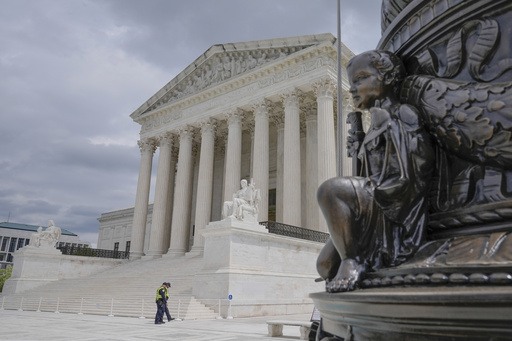WASHINGTON (AP) — The Supreme Court on Wednesday ordered Louisiana to hold congressional elections in 2024 using a House map with a second mostly Black district, despite a lower-court ruling that called the map an illegal racial gerrymander.
The order allows the use of a map that has majority Black populations in two of the state’s six congressional districts, potentially boosting Democrats’ chances of gaining control of the closely divided House of Representatives in the 2024 elections.
The justices acted on emergency appeals filed by the state’s top Republican elected officials and Black voters who said they needed the high court’s intervention to avoid confusion as the elections approach. About a third of Louisiana is Black.
The Supreme Court’s order does not deal with a lower-court ruling that found the map relied too heavily on race. Instead, it only prevents yet another new map from being drawn for this year’s elections.
The Supreme Court could decide at a later date to hear arguments over the decision striking down the Louisiana map.
The court’s three liberal justices dissented from Wednesday’s order. Justice Ketanji Brown Jackson wrote that the judges who struck down the latest map should have had the chance to produce a new map before the high court intervened.
“There is little risk of voter confusion from a new map being imposed this far out from the November election,” Jackson wrote.
Liberal justices have dissented from prior Supreme Court orders that put decisions near elections on hold. Those orders invoked the need to give enough time to voters and election officials to ensure orderly balloting. “When an election is close at hand, the rules of the road must be clear and settled,” Justice Brett Kavanaugh wrote two years ago in a similar case from Alabama. The court has never set a firm deadline for how close is too close.
Louisiana Attorney General Liz Murrill said she was pleased with the order. “The Secretary of State has consistently stated she needed a map by May 15,” Murrill said in an emailed statement. “The plaintiffs did not contest it at trial. We will continue to defend the law and are grateful the Supreme Court granted the stay which will ensure we have a stable election season.”
A lawyer for the Black voters praised the court’s action. “We are very relieved that SCOTUS agreed with us that it’s too close to the election to insert uncertainty. … We will have a map with 2 majority black districts this fall,” Jared Evans, an attorney with the NAACP Legal Defense and Education Fund, wrote in a text using an abbreviation for the Supreme Court.
Edward Greim and Paul Hurd, attorneys for plaintiffs who challenged the new map said Wednesday’s order lets the state impose a “brutal racial gerrymander” on 2024 voters who will cast ballots in districts “segregated by race.” But they predicted eventual victory in the case.
Louisiana has had two congressional maps blocked by federal courts in the past two years in a swirl of lawsuits that included a previous intervention by the Supreme Court.
The state’s Republican-dominated legislature drew a new congressional map in 2022 to account for population shifts reflected in the 2020 Census. But the changes effectively maintained the status quo of five Republican-leaning majority white districts and one Democratic-leaning majority Black district.
Noting the size of the state’s Black population, civil rights advocates challenged the map in a Baton Rouge-based federal court and won a ruling from U.S. District Judge Shelly Dick that the districts likely discriminated against Black voters.
The Supreme Court put Dick’s ruling on hold while it took up a similar case from Alabama. The justices allowed both states to use the maps in the 2022 elections even though both had been ruled likely discriminatory by federal judges.
The high court eventually affirmed the ruling from Alabama and returned the Louisiana case to federal court, with the expectation that new maps would be in place for the 2024 elections.
The 5th U.S. Circuit Court of Appeals gave lawmakers in Louisiana a deadline of early 2024 to draw a new map or face the possibility of a court-imposed map.
New Gov. Jeff Landry, a Republican, had defended Louisiana’s congressional map as attorney general. Now, though, he urged lawmakers to pass a new map with another majority Black district at a January special session. He backed a map that created a new majority Black district stretching across the state, linking parts of the Shreveport, Alexandria, Lafayette and Baton Rouge areas.
A different set of plaintiffs, a group of self-described non-African Americans, filed suit in western Louisiana, claiming that the new map was also illegal because it was driven too much by race, in violation of the Constitution. A divided panel of federal judges ruled 2-1 in April in their favor and blocked use of the new map.
Landry and Murrill, a Republican ally, argued that the new map should be used, saying it was adopted with political considerations — not race — as a driving factor. They note that it provides politically safe districts for House Speaker Mike Johnson and Majority Leader Steve Scalise, fellow Republicans. Some lawmakers have also noted that the one Republican whose district is greatly altered in the new map, Rep. Garret Graves, supported a GOP opponent of Landry in last fall’s governor’s race. The change to Graves’ district bolsters the argument that politics was the driving factor rather than race, lawmakers have said.
Voting patterns show a new mostly Black district would give Democrats the chance to capture another House seat and send a second Black representative to Congress from Louisiana. Democratic state Sen. Cleo Fields, a former congressman who is Black, had said he will run for Congress in the new district, if it’s in place for the next election.
___
McGill reported from New Orleans.



